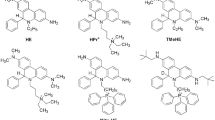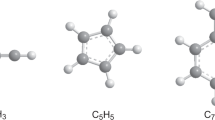Abstract
CONSIDERABLE controversy1–3 has centred around the effect of excess charge on the magnitude of proton coupling constants in such radicals as the cations and anions of aromatic hydrocarbons, benzene, naphthalene and anthracene. Simple theories predict that the coupling constants for cations and corresponding anions should be equal, whereas electron spin resonance results show that the cations always have larger values (Table 1).
This is a preview of subscription content, access via your institution
Access options
Subscribe to this journal
Receive 51 print issues and online access
$199.00 per year
only $3.90 per issue
Buy this article
- Purchase on SpringerLink
- Instant access to full article PDF
Prices may be subject to local taxes which are calculated during checkout
Similar content being viewed by others
References
Bolton, J. R., J. Chem. Phys., 43, 309 (1965).
Colpa, J. P., and Bolton, J. R., Mol. Phys., 6, 273 (1963).
Giacometti, G., Nordio, P. L., and Pavan, M. V., Theoret. Chim. Acta, 1, 404 (1963).
Symons, M. C. R., and Wardale, H. W., Chem. Commun., 758 (1967).
Melchior, M. T., J. Chem. Phys., 50, 511 (1969).
Ayscough, P. B., Electron Spin Resonance in Chemistry (Methuen, London, 1968).
Bloom, M. B. D., Eachus, R. S., and Symons, M. C. R., Chem. Commun., 1495 (1968).
Carrington, A., Dravnicks, F., and Symons, M. C. R., J. Chem. Soc., 947 (1959).
Author information
Authors and Affiliations
Rights and permissions
About this article
Cite this article
SYMONS, M. Proton Hyperfine Coupling Constants in Radicals and the Excess Charge-effect. Nature 224, 686 (1969). https://doi.org/10.1038/224686a0
Received:
Issue date:
DOI: https://doi.org/10.1038/224686a0



